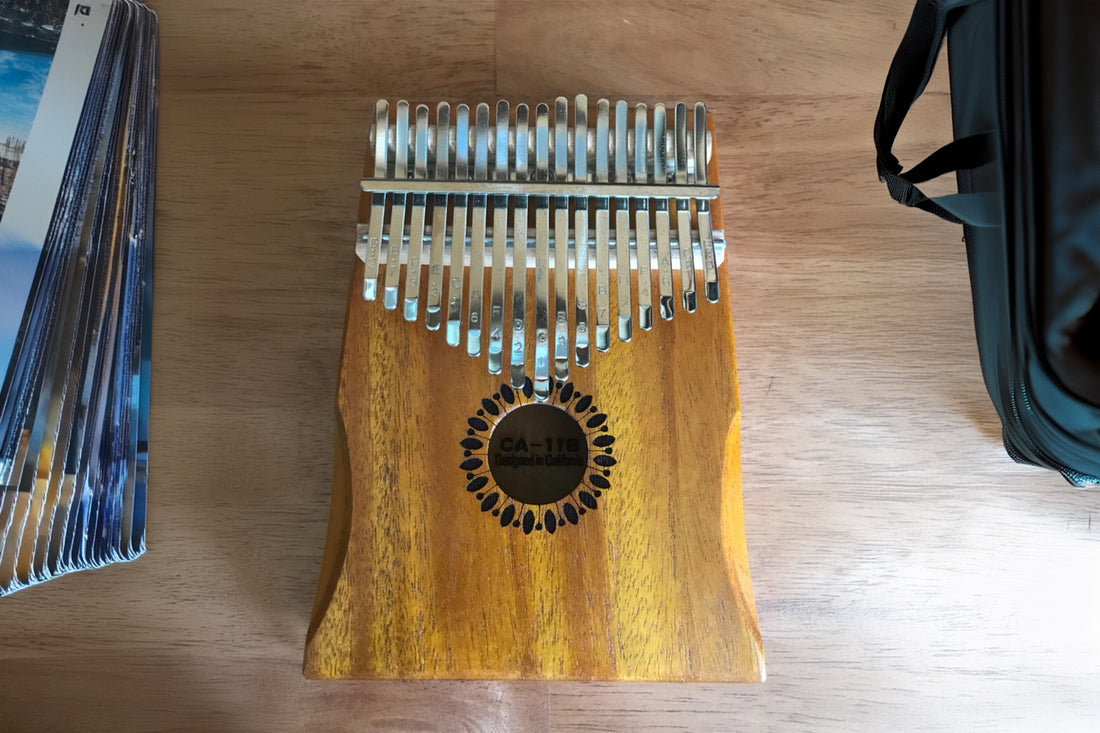
Overture of an Odyssey
Share
" In the quaint seaside town of Sorrento, where the cliffs embrace the azure embrace of the Mediterranean, my love for music was born. It was in this picturesque corner of Italy, among the lemon groves and sun-drenched piazzas, that I discovered the rhythm of life that flows as relentlessly as the tides. My name is Matteo, and I am no prodigy nor a maestro; rather, I am a wanderer at heart, a seeker of melodies and experiences that resonate deeper than the mere surface of everyday life. "
My childhood was steeped in the traditional sounds of Italian music—accordion melodies floated through the air like fragrant aromas from the kitchens. However, it was not until a fateful encounter at a local market that I stumbled upon what would become my constant travel companion and a herald of my journey across cultures—the kalimba and the brand is Newlam.
This modest instrument, with its wooden body and metal tines, was as unassuming as it was enchanting. It captivated my imagination not with grandeur but with the purity of its sound and the promise of a musical voyage that could bridge continents.
As I grew older, the desire to explore beyond the familiar horizon of Sorrento grew irresistible. Inspired by tales of artists and musicians who roamed the world, turning every street corner and café into a stage for their art, I decided to embark on a journey across Western Europe. With a sturdy backpack, a collection of maps, and my cherished kalimba, I set out to discover the symphony of landscapes and cities, each with their own unique cadence and culture.

The Call of Paris
My journey began in Paris, the city of light and an eternal muse for the romantics and the dreamers. Paris was a living canvas, each brushstroke a street, each colour a note in the city’s vast repertoire of sounds. Here, the past and the present perform a delicate dance, witnessed by the stone angels perched atop Notre Dame and the sleek glass pyramids of the Louvre. It was here that I first truly understood the power of the kalimba. In the bustling artists' haven of Montmartre, with the Basilica of the Sacré-Cœur looming majestically in the distance, I found a spot by a sunlit wall adorned with ivy. As I played, the notes spilled out, simple yet profound, weaving through the chatter and the laughter of the crowd. The music drew listeners, their curiosity piqued by the sight of this exotic instrument in the hands of an Italian.
Parisians, I learned, are an audience with discerning tastes, cultivated through centuries of exposure to the finest arts. Yet, they embraced the kalimba’s melodies, finding something universally touching in its plucked tunes that spoke of both sorrow and joy, of farewells and of meetings. As night fell over Paris, the city transformed under the glow of streetlamps, and the cafes filled with the warm buzz of conversation. In one such cafe, a small establishment with walls lined with books and artwork, I performed to a gathered crowd. The evening was one of connection, not just of people, but of cultures; through the kalimba, I shared stories of Italy, my music a bridge over the Mediterranean, linking Sorrento to Paris.

Crossing into Belgium
With each passing day, the road called, and I heeded its call, travelling north to Belgium. Belgium offered a stark contrast with its gothic architecture and the modernist lines of its institutions. Yet, it was in the medieval city of Bruges that I found a reflective peace. The city, with its cobbled streets and silent canals, seemed suspended in time, a perfect place for introspection and music. Here, beside the tranquil waters of the Minnewater, I sat many afternoons, my fingers dancing over the kalimba as swans glided by, their movements as graceful as the flowing melodies.
Bruges was a city that listened, and as I played, people from all walks of life gathered—tourists sketching the vistas, locals enjoying a moment of respite, children with wide-eyed wonder. The kalimba’s music filled the air, a serenade to the city’s history and beauty. It was here in Bruges that I met Clara, a kindred spirit whose love for the arts was matched only by her curiosity about the world. Our meeting was serendipitous, a shared moment by the water where music and conversation flowed as freely as the canal beside us.
Together, we explored the musical landscape of Belgium, from the jazz clubs of Brussels, where the music thrummed with life and vibrancy, to the quiet, leafy parks where the world seemed to pause, listening. Clara, intrigued by the kalimba’s simplicity and depth, soon became not just a friend but a fellow musician, eager to learn and explore the myriad tunes that could be coaxed from its metal tines.

Amsterdam’s Lyrical Lanes
The journey continued, with the road winding through the flat lands of the Netherlands. In Amsterdam, a city famed for its artistic heritage and bustling canals, the kalimba found new audiences. The Dutch, with their pragmatic yet open-hearted approach to life, welcomed the melodies that I brought to their city. In the verdant expanse of Vondelpark, among tulips and tranquil ponds, I played for picnickers and cyclists, the music a gentle accompaniment to their leisurely pursuits.
One night, in a cosy bar near the centre of Amsterdam, I joined a group of musicians for an impromptu session. The mix of the kalimba with traditional Dutch instruments created a fusion that was both unexpected and delightful. The audience, a blend of locals and travellers, applauded the blend of cultures, a testament to music’s power to unite and inspire.
As the evenings drew in and the city of Amsterdam twinkled with the soft glow of streetlights and canal reflections, the music continued to flow. The kalimba, which began its journey as merely an instrument, transformed into a medium of stories and emotions, an echo of the places and faces I had encountered. Each note played was a reflection, each melody a memory etched into the soundtrack of this grand tour.

The German Experience
From the Dutch landscapes, my travels took me deeper into the heart of Europe, to Germany—a country marked by its profound history and rich cultural tapestry. My first stop was Berlin, a city that stands as a testament to resilience and renewal. Here, amidst the remnants of walls that once divided, now stood vibrant galleries, bustling markets, and open parks where history and modernity mingled seamlessly.
In Berlin, the kalimba resonated with a deeper timbre, its melodies reflecting the poignant echoes of the city’s past. I played in the shadows of the Brandenburg Gate, where tourists and locals alike paused in their tracks, drawn by the curious harmony of African instrument and European backdrop. The kalimba’s music seemed to capture the essence of Berlin’s spirit—its capacity for sorrow and its immense strength in rebirth.
One particularly memorable evening occurred in a mini art gallery in the Mitte district, where I was invited to perform during an exhibition of local artists. The pieces displayed ranged from abstract interpretations of Berlin’s architecture to expressive portraits of its citizens. My music accompanied the visuals, each pluck of the kalimba’s keys a complement to the strokes of the artists’ brushes. The performance was not merely musical; it was an immersive experience that allowed the audience to feel the city’s heartbeat through a blend of art and melody.

Journey Through the Alps
Leaving the vibrant urban landscapes behind, I ventured towards the tranquillity of the Swiss Alps. The stark contrast between the bustling cities and the serene mountains of Switzerland provided a refreshing change of pace. In Lucerne, nestled amidst the mountains and the lake, the kalimba found a new voice—a voice that mirrored the quiet majesty of the alpine scenery.
Here, by the shores of Lake Lucerne, I would sit for hours, playing to the backdrop of the Pilatus mountain range, the notes floating over the water, mingling with the crisp alpine air. The locals, accustomed to the sounds of classical and folk music, found the kalimba’s melodies both exotic and captivating. It was during one of these sessions by the lake that I met Anja, a cellist, who was intrigued by the contrast between her deep, resonant cello tones and the crisp, percussive sounds of the kalimba.
We collaborated on several pieces, experimenting with the fusion of our instruments. The combination was harmonious and refreshing, creating a musical language that transcended the traditional boundaries of our separate cultures. These sessions became a highlight of my time in Switzerland, each performance an exploration of new musical landscapes.

The Italian Return
Eventually, the roads led back to Italy, to Sorrento, where the journey had begun. Returning home with a kaleidoscope of memories and melodies, I found that my perception of my hometown had changed. Sorrento was no longer just a place I knew by heart, but a part of a larger world, a note in a much grander composition.
Sitting on the cliffs overlooking the Mediterranean, kalimba in hand, I played, the notes a reflection of the journey—each song a chapter, each melody a story. The music had evolved, enriched by the experiences and the souls I had met along the way. It was here, in the embrace of home, that I realized the journey was not merely about discovering new landscapes, but about seeing the familiar with new eyes, hearing the known with fresh ears.
Epilogue: The Melody Continues
The travels may have paused, but the music continues. The Newlam kalimba, once a simple musical instrument, is now a repository of countless stories, an archive of emotional landscapes. It continues to inspire, to soothe, and to connect, reminding me that music, like the sea, is universal—flowing, reaching, and embracing all who listen.
This narrative is not just about the places traversed or the notes played; it’s about the power of music to transcend boundaries, to communicate without words, and to unite disparate souls. As I look forward to the next journey, the kalimba remains by my side—a constant reminder that every end is just another beginning in the symphony of life.
